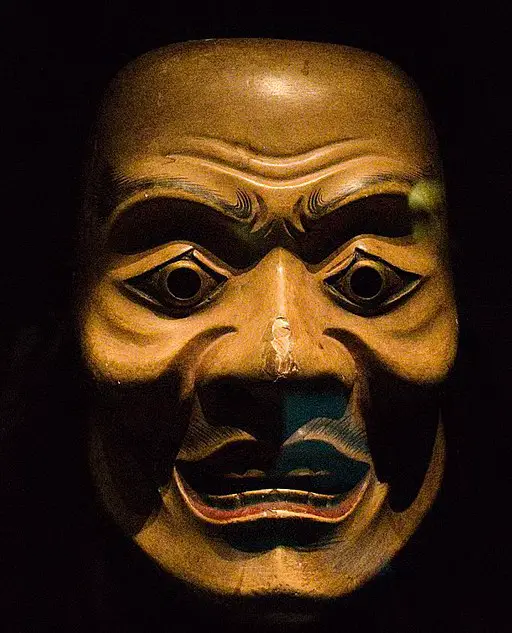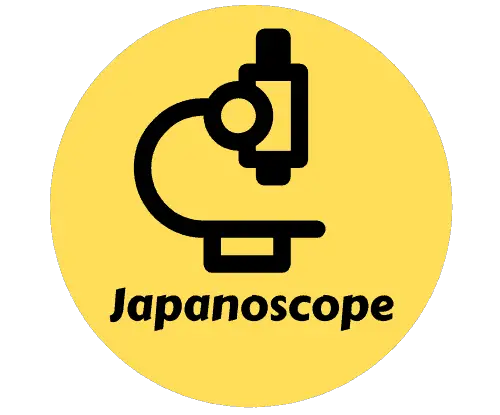
image: Grahn [CC BY-SA (https://creativecommons.org/licenses/by-sa/3.0)]
There is magic in a mask. They have held a timeless mystery for humans across geography and history.
Their power is in their ability to make it possible for a human to take on a new identity; to transform.
I’ve had the opportunity to take part in several festivals in Japan over the years, some of which have included masks. It has struck me that the mask, and to a lesser extent all ritual dress, has the ability to momentarily collapse the social class system. In the masked dance, the financial executive is as unknown as the laborer. In this way a mask really is magical. In that moment, you can be anyone.
Japan has a rich folklore filled with fantastic creatures transforming and shapeshifting. Which came first, was it the love the mask or the love of the idea of transformation?
Only the sly fox knows.
What Types of Japanese Face Masks are there and what do they mean?
Largely, we can divide Japanese masks into two categories; masks used for performance and masks used in festivals. Broadly, performance masks are associated with the ruling classes of society and more secular occasions and the festival masks are associated with common people and more rituals. The ideas of “secular” and “religious” tend to blend in Japan, so this is really an arbitrary means to simplify the situation. Spirituality is a deep soup that spills easily.
Performance Masks
Noh Theatre has a history that goes back to at least the 12th or 13th century. The term “Noh” Theatre itself is relatively new and was only used from the Meiji period in the late 1800s. Until then it was sarugaku, which roughly translates as “Monkey Amusement”. There are other influencing art forms such as Sangaku that go back to the period of Chinese cultural influence around the 6th century.
For my part, I had a short experience learning some of the fundamentals of Noh for a semester as a student at the Kyoto City University of the Arts. A member of the Kongo house of Noh in Kyoto taught us how to intone in various strange guttural incantations.
Noh Masks
Really there are as many types of masks in Noh as there are Noh plays. They get categorised in a few different ways. One method divides them into seven types, which we will use here.
Okina 翁
Okina style mask
Image: https://www.flickr.com/photos/norio_nomura/
Okina, comes from an old Japanese word for an old man. Usually an Okina mask has a relatively calm expression. The mask features distinctive bushy eyebrows. It is in two parts with a separated jaw. It is also referred to as kami no men 神の面 meaning “mask of god” and is considered sacred.
Jou 尉
Refers to all old men characters other than Okina. Jou can be hard to distinguish from Okina, but is associated with the human face of an old man, distinct from the God-like status of Okina. Although, even this distinction is blurred as the Jyo can be called “Kojyo” 小尉, which is also a manifestation of a god in human form. The jyo can also express the melancholy side of the human condition.
Onikami 鬼神
Kakidai [CC BY-SA (https://creativecommons.org/licenses/by-sa/4.0)]
Oni means a demon and kami means a god. There are various demons and gods which appear in Noh Theatre, such as Fudo Myoou 不動明王. A lot of these masks don’t look friendly and can represent the dead, or souls in hell. They can also be calmer more enlightened beings.
Otoko 男
Daderot [Public domain]
Otoko is a modern one simply meaning “man” in Japanese. These masks include the normal manly culprits including military ranking officials and middle aged men of honour such as this Chujo 中将. These masks can sometimes have something of a pensive expression.
Onna 女
Daderot [CC0]
Perhaps saying something interesting about the place of women in traditional Japanese society, the onna or female mask generally expresses a neutral expression. For this reason, it is said that the mask is able to express a variety of emotions depending on the movements of the actor.
Strikingly to Western eyes, the eyebrows are very high up on the forehead. This is not an artistic license taken by mask makers. It was common practice for hundreds of years for women in Japan to shave off their eyebrows and then draw them on again as light shaded patches high up on the forehead in the practice of hikimayu 引眉. One theory to why this is is that real eyebrows got in the way when women started painting their faces white.
You’ll also notice that the teeth are black. Once again, this is a true depiction of life, where Japanese women often painted their teeth black, called ohaguro お歯黒, both for aesthetic and dental reasons.
Onryo 怨霊
These fear inducing masks represent jealous, vengeful and pained spirits. Most famous of these is the Hanya 般若 mask, which represents a female spirit with who is full at spite, often for being wronged by someone or something. Interestingly, Hanya is a translation of the Sanskrit word of Prajna, used in buddhism to denote “wisdom”. Why the word has come to be used for a crazed vengeful spirit is not 100% clear. One theory is that there was a buddhist priest who used the name Hanya who first created these scary masks. Another theory is that a character in the famous Japanese classical text, , a character got rid of an evil spirit by reciting a Hanya buddhist text.
Ritual Masks
Namahage なまはげ
Image: https://commons.wikimedia.org/wiki/User:Akira_Kouchiyama
Namahage events take place all around the Oga Peninsula in Japan, especially around the New Year’s period. The main thing to note about these masks is that a Namahage is not an Oni or a demon. He’s a good guy! Though looking fierce, and to the untrained eye as demonic, a namahage is actually a fortuitous messenger of Godly character.
Masks can be found that are particular to each district and the entire namahage tradition was registered as a UNESCO Intangible Cultural Heritage item in 2014.
Hyottoko ひょっとこ
I first encountered this funny fella in a local festival on the Southern Island of Kyushu. I put on the mask and the little troupe I was part of showed me how you do the Hyottoko by thrusting out your hips in a vulgar jerking motion. Actually, everything about the Hyottoko character is vulgar. That’s the point. He is a classic buffoon. Eyes dishevelled, mouth twisted, wearing a spotted hanky around his face. One theory behind his name is that the word is an evolution of hi, meaning fire, and otoko, meaning man. The story goes that his mouth twisted and pointed like that because he is blowing on a flame, and that he is wearing the hanky to stop himself from getting burnt. He is a working man.
He is considered a bringer of good fortune. And why wouldn’t he be, a salt-of-the-earth, larrikin, wise guy, not afraid to make himself the butt of the joke for his comrade’s amusement. He reminds us, especially at times of festival and merry-making, that we shouldn’t take ourselves too seriously.
Okame おかめ
Often forming a pair with her pal Hyottoko is Okame. She’s a voluptuous, plump-cheeked maiden, ever smiling and endlessly benevolent. Okame means turtle in Japanese and there is a theory that her chubby face looks like the shelled water-reptile. Turtles are also, along with Cranes, considered to be one of the most luck-bringing animal totems in Japan. Okame’s other numerous names include Otafuku, which may come from the words ta, or greatly, and fuku, which can be taken as a word to refer to all things good including fortune, wealth and health. In ancient times, a chubby woman was considered to be a lucky charm that could ward off disease and evil spirits. Fat was beautiful. As perceptions of beauty have changed over time, words such as Otafuku have sadly sometimes come to be used to as insults to women. Our original Okame remains perpetually unfaised though. She just keeps smiling and puffing out her cheeks and dancing graciously.
Fox kitsune 狐
The Kitsune fox is the classic shape shifter of Japanese folk-lore. Foxes can turn into humans to make mischief. They are often seen outside Shinto shrines. They occupy a moral space that is ambiguous, sometimes being seen as totem of reverence and other times one to be feared. In this way they mirror the ambiguities of the nature of another creature prone to ethical transformation, the humble human.
REVIEWS: Best Japanese Masks To Buy Online
Best Masks For Wearing
Hyottoko Mask
This is the most popular character for festivals across Japan. Put this on and ignite your inner goof.
Pros
Classic, instantly recognisable Hyottoko design
Handmade – each one is it’s individual piece
Paper mache – not plastic
Cons
No hole in mouth – so may need to pierce to breathe
Eye holes quite small
Okame Mask
This is the most popular woman’s character for Japanese Festivals. She’s convivial, she’s well fed, she’s got shaved eyebrows. What’s not to love?
Pros
Classic, instantly recognisable Okame design
Handmade – each one is it’s individual piece
Paper mache – not plastic
Cons
No hole in mouth – so may need to pierce to breathe
Eye holes quite small
Blue Kitsune Fox Mask
The famous shape shifter of Japanese folklore.
Pros
Instantly recognisable kitsune design
Backing strap for wearing
Cons
No hole in mouth – so may need to pierce to breathe
Red color is more instantly recognisable for kitsune
LED Lighted Kitsune Fox

The famous shape shifter gets a disco twist!
Pros
What can we say? It LIGHTS UP!
Covers half the face, leaving mouth to breathe
Large eye holes
Three flashing modes
Runs for 10-15 hours
Cons
Non-traditional
Doesn’t cover whole face
Battery pack may be too bulky for some
Red Demon Oni Airsoft Mask
If you really want to scare people, this modern twist on a Japanese folk demon is the limousine of masks.
Pros
“Strong as a hockey mask” fibreglass construction
Eye protection in black steel mesh makes the mask good for shooting games
Flexible foam inside moulds to face
One size fits all
Cons
Eye mesh may decrease visibility
Fairly Heavy
Custom Made Kitsune Fox on Etsy
Pros
Totally home made to order
Individual craftsmanship
Three way, thick strap holds securely on head
Padding inside
Cons
Relatively expensive
6-8 week order time
Backing strap for wearing
Best Japanese Masks For Display Purposes
Hyottoko Display Mask
The wacky folk-fellow of Japanese festive cheer. How could you take yourself too seriously with this rube hanging around?
Pros
Mounted on wooden board
Ceramic item
Can be bought as a set with Okame
Cons
Hanging string not hidden behind hanging board
Okame Display Mask
The chubby lady of the many a Japanese festival fame. Her puffy cheeks are good luck, and who doesn’t need a bit more of that in their life?
Pros
Mounted on wooden board
Ceramic item
Can be bought as a set with Hyottoko
Cons
Hanging string not hidden behind hanging board
Noh-Style Woman’s face Mask

Reminiscent of a Noh mask, but more brightly colorful
Pros
Mounted on wooden board
Ceramic item
Can be bought as a set with Hyottoko & Okame
Cons
Hanging string not hidden behind hanging board
Japanoscope is a participant in the Amazon Services LLC Associates Program, an affiliate advertising program designed to provide a means for sites to earn advertising fees by advertising and linking to amazon.com








